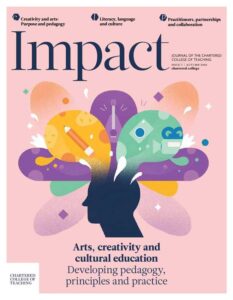The experience of generalists teaching art: Reflection on the lived experience

This research project was designed to understand the lived experience of nine general practitioners teaching art; three from primary schools in the UK and six from elementary schools in the US. It used a reflective-formative style of inquiry, relying on Dewey’s (1933) theory of knowledge (experience + reflection = new knowledge). Teachers from the UK and the USA were observed for one art lesson, followed by a reflective discussion of the observation. Various themes emerged from the analysis of the participants’ narratives, including challenges of teaching art relating to budget, curriculum and training, as well as concerns over pedagogy and planning.
The research project was designed at a challenging time for art educators. Art education in the United States and England is in a constant state of flux; as the economy and political interests have changed, so has art education (Sabol, 2013; Steers, 2013). Not all teachers are comfortable teaching art (Miraglia, 2008; Stokrocki, 1995), and not all teachers have been trained in art education. The key objective of the research was to provide insights into teaching in an effort to make change, unpacking the complexities that are a part of the act of teaching, to improve not only teaching but also the effect of teaching on students (Fitchman Dana and Yendol-Hoppey, 2014).
Framework and methods
The research not only includes the teacher but also requires the teacher to engage in active reflection and understanding (meaning-making). The teachers are not simply subjects/objects in the study, they also gain knowledge from doing and reflecting on their doing (Dewey, 1933). The collection of teacher experiences and reflections helps to explain teacher pedagogy, highlighting the challenges and solutions that teachers discover in the classroom while teaching art.
The teachers included Ann, Bob and Carol, who were from a primary school in England. Dee, Eve and Fran were from a low-income school in California, and Gina, Hana and Ivy taught in a private Montessori school in Texas. Teachers were observed for one art lesson, followed by a reflective discussion-style interview with questions specific to their observation. Bricolage was employed (using a field journal, notes, photographs and transcription of interview imported into NVivo) to identify themes. Participants willingly opened their classrooms and professional space to share their lived experiences for the research.
Results
The study created nine individual narratives of each participant’s experience (see Figure 1 for demographics). Each of the teachers experienced the teaching process differently (see Figure 2), based on their level of experience, grade teaching, school setting and students.

Figure 1

Figure 2
For some, the experience of teaching art was arguably more of a learning experience for them than it was for their students. Regardless, none of the participants felt fully prepared or confident in their own art skills or their ability to teach art. Others identified that they were not teaching art but facilitating studio time or supporting experimentation (no assessment of learning). A few of the participants got frustrated with the activity and the energy that students encounter when creating, and felt it necessary to control the art lesson (step-by-step directed instructions) in order to maintain the class composure and prevent chaos. Challenges from teaching art included budget, curriculum and training.
Extracts from the raw data share the voices of the teachers, the context and how each is different from the other:
I think it’s always hard explaining things in art; it was good, I had fun. I like doing art with them. They are always really excited about it, so that’s nice. (Carol)
I get the instructions and they get the materials and they get started; it seems like everything kind of just like takes its natural pacing and I relax a little bit and I’m able to enjoy watching them create, watching them, you know. (Eve )
We’re not actually really learning, just experimenting, and it’s personal. So, what matters is what you feel about it. I’m frustrated because the end result wasn’t ultimately correct and what I expected. (Ann )
I am not an artist! I do not like art, I do not frequent museums, you could not pay me to attend, even if a woman I dated wanted to go, I would pass. I just don’t understand the value… Honestly, I wouldn’t teach it if I didn’t have to. I think we met the goal of the lesson… I was scared the students wouldn’t catch on to what I was doing. How else would I teach it? I didn’t have another plan to get the point across. (Bob)
Reflections included themes ranging from pedagogy and planning to self-improvement (see Figure 3). Each and every reflection is different, yet significant to the context and environment of each teacher. It is also necessary to mention that while reflection provides information that teachers can learn from, not all teachers have or make time to reflect and, even if they did have/make time, not all teachers want to reflect and potentially change. They are comfortable within the status quo of their pedagogy. Those that were open to change discovered multiple ways to modify their teaching methods after the reflective interview. Overall, the teachers used their known pedagogies (from teaching other subjects) to teach art.

Figure 3: Participants and reflected topic
Once again, teacher voices further explain the variations of reflection within the context of each teacher:
But in retrospect, if they’re not happy with what they’ve done, how can I help them move forward? If we just stop now, I feel really defeated because I haven’t allowed them, really, to achieve anything. I said to them, ‘There is no right or wrong.’ But I didn’t really let them have a wrong. I wanted them to have my right. And that’s what I learned. And I learned secondly that I would need to do this again. (Ann)
I’m not sure if the students need to know this. It’s not academic, but it supports academics. I think writing a narrative or presenting and describing it to the class would be an interesting modification. I’m not going to teach skills I don’t know myself. How would I do that? (Dee)
I’m glad that you pointed that out that I reversed roles. I don’t know that I usually do that, I certainly did not plan it. They really enjoyed teaching me, modelling me, because it is important for them to know that they have information to add. And to let them be the teacher. I will have to try that again in the next lesson. (Fran)
I’m a processor, thinking, talking to myself. So… I should have practised myself. I tried to cram in all these things, that’s me not self-editing. I want to bring the love and the wonder of learning to them and for each person to be fully who they are. (Ivy)
Surprisingly, all teachers expressed the notion that art is different from other subjects (see Figure 4). They identified that art provides an environment to learn (craft, skills and knowledge), to express (self and emotion), to relate (to the world around them, culture and religion) and to develop empathy, all correlating with Hetland et al.’s ‘studio habits’ (2013). Additionally, all mentioned that while they may have practised art/craft at some point in their lives, they were not trained on how and/or what to teach to students.

Figure 4: Participant voice identifying the eight studio habits
Significance
The study illuminated both positive and negative experiences, as well as reflections that will potentially improve student learning. The study gave voice to the participants that were willing to share their experience, challenges, emotions and reflections, in the hope of improving not only their personal experiences but the experiences of other general teachers and their students. By using their direct voices, academics, researchers and other teacher trainers can modify curriculum and instruction to better meet the needs of the teacher, who, in turn, wants to meet the needs of their students.
The unique framework allowed the research to focus on their experiences of teaching art and their reflections, and to illuminate a new understanding from their perspectives (rather than the researcher’s). This process was symbiotic and became the framework and the motivation to modify their pedagogy to meet the needs of their students. Ultimately, the teachers want to support their students in the best way for their students in their context. They knew that art improves their students and their classroom, but not why. They were challenged by constraints (budget, curriculum and training) and want support to be able to provide the best practices in the classroom, regardless of policy, if they are going to remain responsible for art education. Further, exploring the pedagogy of art education posed additional thought and consideration to the teachers for their future practice and incorporation of ‘the work of art’ – which is active, and is therefore not the same as the product of art – into their classrooms (Dewey, 2009).
References
Dewey J (1929) The Sources of a Science of Education, in the Later Works (1925–1930). Carbondale (IL): Southern Illinois University Press.
Dewey J (1933) Exprience and Education. New York: Collier Macmillian.
Dewey J (2009) Art as Experience. New York: Perigee Books.
Fitchman Dana N and Yendol-Hoppey D (2014) The Reflective Educator’s Guide to Classroom Research: Learning to Teach and Teaching to Learn through Practitioner Inquiry, 3rd edition. Thousand Oaks: Corwin, Sage.
Hetland L, Winner E, Veenema S et al. (2013) Studio Thinking 2: The Real Benefits of Visual Arts Education. New York: Teachers’ College Press.
Miraglia K (2008) Attitudes of pre-service general education teachers toward art. Visual Arts Research 34(1): 53–62.
Moules N, McCaffrey G, Field J et al. (2015) Conducting Hermeneutic Research: From Philosophy to Practice. New York: Peter Lang.
Sabol R (2013) Seismic shifts in the education landscape: What do they mean for arts education and arts education policy? Arts Education Policy Review 114(1): 33–45.
Steers J (2013) Art and design education at the crossroads. In: Addison N and Burgess L (eds) Debates in Art and Design Education. London: Routledge, pp. 11–22.
Stokrocki M (1995) Creative tension: Problems in teaching art education to preservice classroom teachers. In: Galbraith L (ed) Preservice Art Education Issues and Practice. Reston (VA): National Art Education Association, pp. 47–54.










